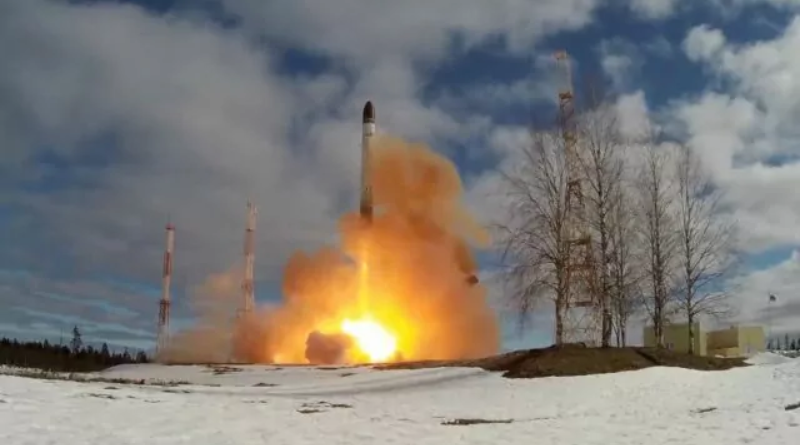Why Did Russia Suspend the New START Treaty?
By Pavel Luzin, Visiting Scholar at The Fletcher School
On February 21, Russia suspended its participation in the New Strategic Arms Reduction Treaty (New START Treaty) of 2010, which had been prolonged in January 2021 until 2026 (Kremlin.ru, February 21; Sozd.duma.gov.ru, February 21). At the same time, Moscow claimed that it will continue to respect the terms of the treaty despite the suspension (Mid.ru, February 21). Yet, one main problem here is that few know the actual state of Russia’s strategic nuclear arsenal, as inspections were paused almost three years ago in March 2020.
Moreover, evidence suggests that Russia did not intend to abide by the New START Treaty after its full-scale invasion of Ukraine, exactly one year ago. To begin with, Russia rejected a resumption of inspections in August 2022 under a number of questionable and insignificant pretexts, including accusations that such inspections give a unilateral advantage to the United States (Mid.ru, August 8, 2022). Then, six months later, Russia appealed to the treaty’s preamble, the changed strategic environment and US arms supplies to Ukraine as justifications for not resuming inspections (Mid.ru, February 8). Meanwhile, Russia made efforts to increase its stock of deployed nuclear delivery vehicles: in the latest release, Russia declared 540 deployed intercontinental ballistic missiles (ICBMs), submarine-launched ballistic missiles (SLBMs) and heavy bombers. This total represents the highest amount throughout the treaty’s history; previously, it never exceeded 528. However, the total number of deployed and non-deployed launchers has remained relatively stable, around 760 (State.gov, March 1, 2022; State.gov, September 1, 2022). It is indeed possible that, by August 2022, Russia had already made the decision to renege on the New START and hoped to leave the impression that it is capable of increasing its strategic nuclear arsenal before disclosing its true intentions publicly.
Nevertheless, Russia inevitably needs to decrease the number of strategic nuclear delivery vehicles in its arsenal. For example, Russia currently possesses 40 deployed liquid-propellant heavy R-36M2 (RS-20/SS-18) ICBMs produced in the late 1980s, down from 46 in 2020 (Russianforces.org, January 2020; Sipri.org, accessed February 24). From 2004 to 2013, the Kremlin conducted regular launches of these ICBMs, which prolonged their service for several years. The last launch in October 2013 prolonged the service life of these missiles for five years; however, after that, Moscow ceased test launches with this particular classification of ICBM. Since 2018, their service life has been extended without tests, and they were originally planned for complete dismantlement by 2024 (RIA Novosti, November 21, 2018; Redstar.ru, December 16, 2019).
The same end-of-service timing was planned for the 45 solid-propellant RT-2PM Topol (RS-12M/SS-25) ICBMs that have allegedly remained in Russia’s arsenal since 2020 (Russianforces.org, January 2020). However, other estimates testify that, in fact, only nine operational Topol ICBMs are available for use (Sipri.org, accessed February 24). If true, this means that, in total, 42 ICBMs had already been dismantled between 2020 and 2022, when inspections were not conducted, and that the other 49 ICBMs are going to be dismantled in 2023–2024. Then, it will be the turn of the remaining 78 Topol-M (RS-12M2/SS-27) ICBMs, which are slated to be phased out of service sometime between 2025 and 2035 (Interfax, November 30, 2010; Interfax, January 27, 2011). In truth, any further lengthening in service life is really only possible on paper.
The situation with SLBMs is almost the same. Russia has one Delta-III (project 667BDR Kalmar) and six Delta-IV (project 667BDRM Delfin) submarines, each equipped with 16 SLBMs. The final Delta-III sub has exceeded 40 years of service, which is at least three years longer than any other submarine of this classification. And despite the overhaul between 2011 and 2017, the added operational lifetime for Delta-IIIs and Delta-IVs usually did not exceed five years (TASS, May 29, 2014).
The remaining Delta-IV submarines are planned to be operational until 2030, when the last submarine of this classification should be dismantled (VPK.name, May 18, 2021). However, in the early 2020s, at least two subs were planned to be dismantled (Eanews.ru, March 19, 2019; Flot.com, April 28, 2021). Without inspections and official announcements, the actual state of Russia’s Soviet-era submarines is unclear, but at least three of them will likely be withdrawn from operational use along with their 48 SLBMs sometime in 2023–2024.
Therefore, at least 97 Russian ICBMs and SLBMs are planned to be withdrawn from operational use in the next couple years. Due to the current decrepit state of Russia’s defense production industry, this decrease in capabilities cannot be fully compensated for in the near future. For instance, the average annual manufacturing rate of the Yars ICBMs from 2009 to 2022 may be estimated at 13 or 14 missiles (the total amount is about 180 missiles), and it hardly exceeds that number today. Between 2013 and 2022, Russia built six Borei-class submarines with 16 Bulava SLBMs on each (see EDM, January 11). The seventh submarine of this type is planned to be operational by the end of 2023, and the other three submarines should be commissioned by 2030. The heavy bombers would be the only relatively stable part of the Russian strategic arsenal, but losses during the war against Ukraine and intensive consumption make this prospect uncertain.
As a result, a significant decrease in Russia’s strategic nuclear arms will take place during the coming years. Given the current state of domestic production, efforts to stabilize the Russian nuclear arsenal and bring it back to the average level maintained throughout the 2010s will only succeed as early as 2030. However, this will only be possible if the Russian military does not encounter troubles with maintaining and manufacturing critical nuclear delivery vehicles. In this way, Russia hopes to keep this decrease in capabilities a secret to salvage any semblance of strategic parity with the United States on the international stage.
This piece is republished from Eurasia Daily Monitor

